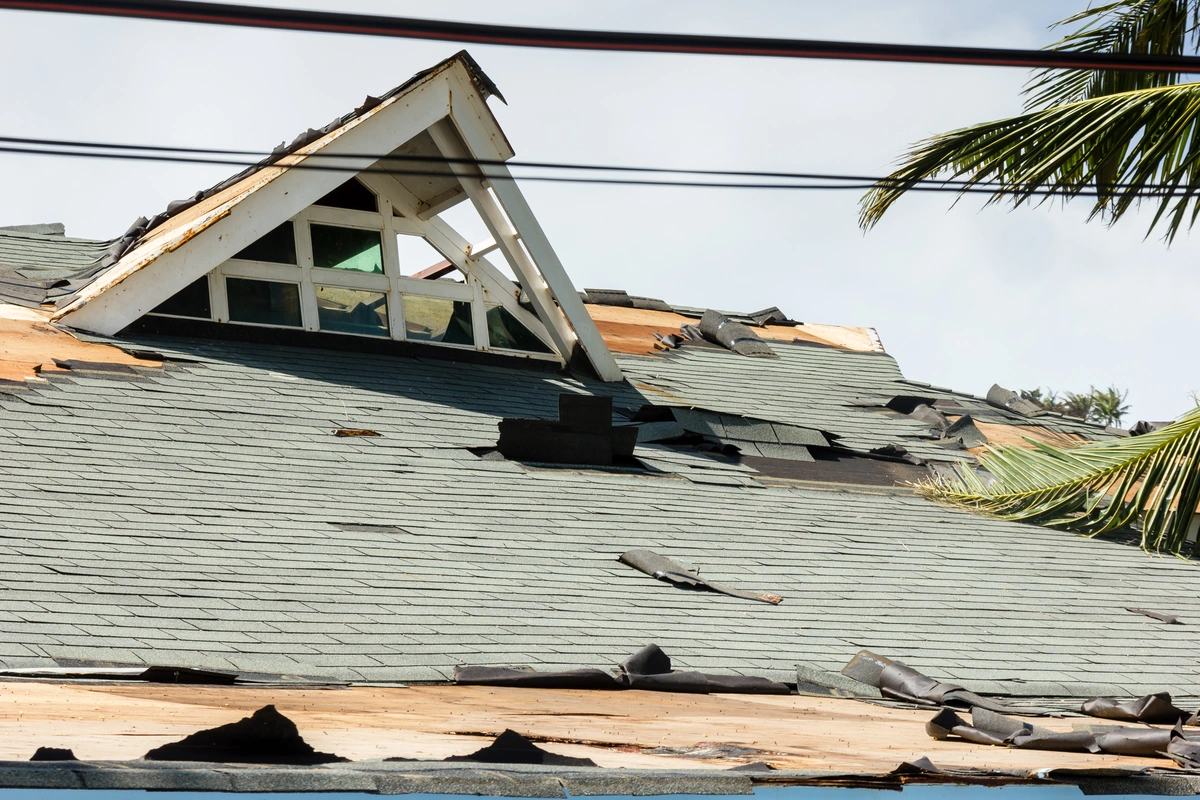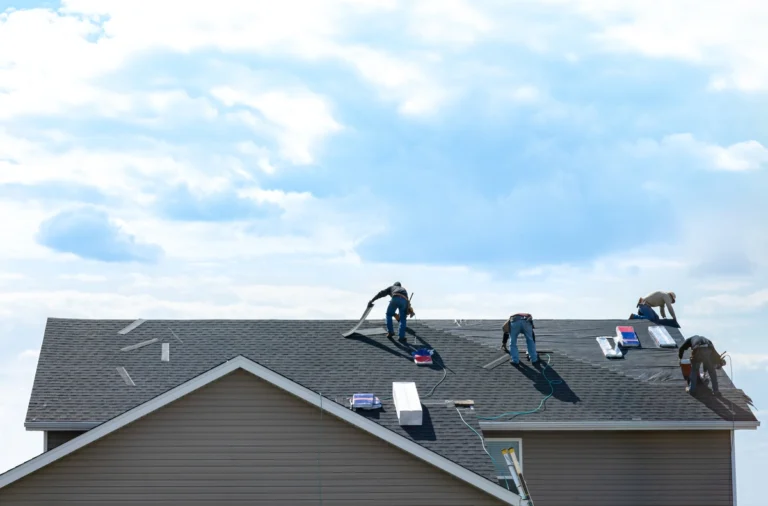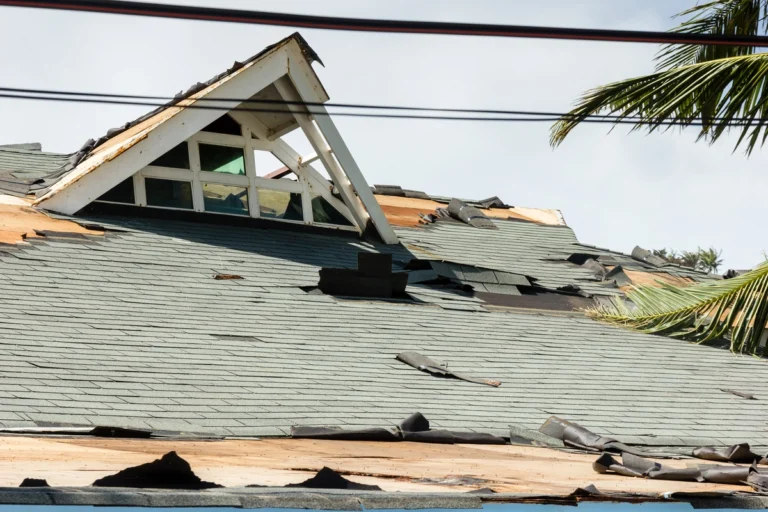Most of the time, we don’t spend much time thinking about our roofs. They’re just there, silently protecting us from the elements. But when disaster strikes, it can quickly change your day.
A damaged roof is a fairly unavoidable part of homeownership. But just because you can’t avoid it doesn’t mean you shouldn’t be prepared!
In this comprehensive guide, we’ll explore:
- The signs of roof damage,
- The potential causes of damage,
- Steps to perform an emergency roof repair
- When to call in a professional
Keep reading for an in-depth understanding of all things emergency roof repair related!
Signs of Roof Damage

Recognizing the signs of roof damage is the first step in preventing further issues. Here are some common signs to watch out for:
- Leakage: One of the most obvious indicators of roof damage is water leakage inside your home. If you notice water stains on your ceiling or walls, it’s a clear sign that your roof needs attention.
- Missing or Damaged Shingles: Inspect your roof for missing, cracked, or curling shingles. Shingles protect your roof from the elements, and any damage can compromise your roof’s integrity.
- Sagging: A sagging roofline is a serious red flag. It may indicate structural damage or excessive moisture absorption.
- Granule Loss: Check your gutters for an accumulation of granules from asphalt shingles. Granules protect shingles from UV rays, so their loss can lead to rapid deterioration.
- Visible Holes or Gaps: Look for visible holes or gaps in your roof’s surface. These vulnerabilities can allow water to seep in and cause extensive damage.
- Interior Damage: Besides water stains, look for damp or moldy insulation and discolored rafters in your attic. These signs indicate that water has penetrated the roofing system.
- Clogged or Damaged Gutters: Clogged or damaged gutters can lead to water overflow, which can damage your roof and create ice dams in colder climates.
Ways Your Roof Can Be Damaged
Understanding how your roof can become damaged is essential for prevention. Here are some common causes of roof damage:
- Weather Extremes: Harsh weather conditions, such as heavy rain, hail, snow, and strong winds, can take a toll on your roof over time. It can cause shingles to loosen or be blown off, leading to leaks.
- Aging: Roofs have a finite lifespan, and as they age, they become more susceptible to damage. Regular maintenance can extend their longevity, but eventually, all roofs will need replacement.
- Poor Installation: If your roof was not installed correctly in the first place, it’s more likely to develop issues. Ensure that you hire a reputable contractor for roof installation.
- Tree Damage: Overhanging branches or falling trees can puncture or crush your roof, causing significant damage.
- Animal Activity: Birds, rodents, and other small animals can create holes in your roof, as well as damage flashing or vents.
- Ice Dams: In cold climates, ice dams can form on your roof, causing water to back up under the shingles. This can lead to leaks and structural damage.
How to Perform an Emergency Roof Repair in 8 Steps

If you identify signs of roof damage, it’s essential to address the issue promptly to prevent further damage. Here’s a step-by-step guide on how to perform an emergency roof repair:
Step 1: Safety First
Before you start any repair, prioritize safety. Ensure that the weather conditions are safe and you have the necessary safety equipment, such as a stable ladder, non-slip shoes, and a safety harness if necessary.
Step 2: Locate the Source of the Leak
If you’re dealing with a leak, locate the source of the water intrusion. Check your attic or crawl space for signs of water entry and trace the path to the damaged area on the roof.
Step 3: Temporarily Patch the Leak
For a temporary patch, use roofing cement or a waterproof sealant to seal the damaged area. Apply the material generously to ensure a watertight seal. If shingles are damaged, replace them using roofing nails.
Step 4: Remove Debris
Clear away any debris, such as branches or leaves, from your roof. Debris can contribute to further damage and clog your gutters.
Step 5: Secure Loose Shingles
If you notice loose shingles, use roofing adhesive to reattach them securely to the roof. Press down firmly to ensure a strong bond.
Step 6: Address Flashing Issues
Check the flashing around chimneys, vents, and skylights. If it’s damaged or loose, reseal it with roofing cement or replace it if necessary.
Step 7: Prevent Ice Dams
If you’re dealing with ice dams, remove snow from the roof using a roof rake. Additionally, ensure your attic is properly insulated and ventilated to prevent future ice dams.
Step 8: Monitor the Repair
After you’ve performed the emergency repair, monitor the situation closely. Watch for any signs of further leaks or damage until you can arrange for a permanent fix.
When to Call in a Professional

While emergency roof repairs can address immediate issues, it’s essential to understand when it’s time to call in a professional roofing contractor. Here are some signs that emergency roof repair services may be needed.
- Extensive Damage: If your roof has suffered significant damage or structural issues, it’s best to leave the repair to professionals.
- Safety Concerns: If the repair requires you to work at heights or in adverse weather conditions, it’s safer to hire a professional with the right equipment and expertise.
- Roof Replacement Needed: If your roof is near the end of its lifespan or has extensive damage, it may be more cost-effective to opt for a roof replacement rather than multiple repairs.
- Insurance Claims: If the damage is due to a covered event, like a severe storm or fallen tree, consider involving your insurance company and hiring a professional to assess and document the damage for your claim.
- Complex Repairs: Some roof repairs, such as complex flashing or underlayment replacement, require specialized knowledge and skills that professionals possess.
Helping You With Your Emergency Repairs
Not a roofing professional? No problem! Our team of professional roofers at Bay Valley Roofing is here to help you through your roofing emergency. Contact us today to set up your appointment and get your roof back in working order!





